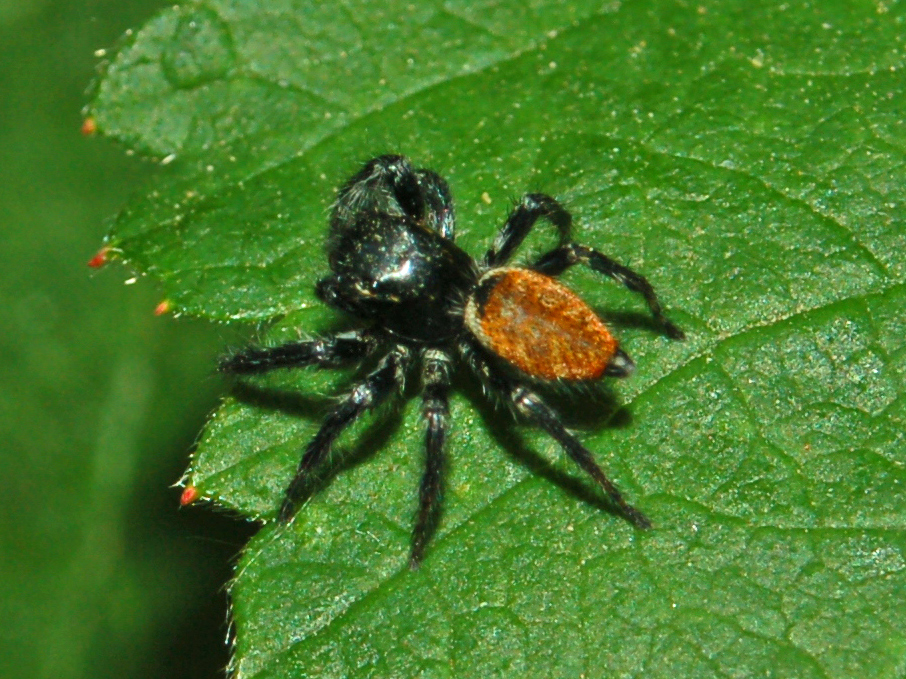Carrhotus Xanthogramma on:
[Wikipedia]
[Google]
[Amazon]
''Carrhotus xanthogramma'' is a species of jumping spider belonging to the family Salticidae.
 The adult males of these jumping spiders reach approximately of length, while females can reach a body length of about .Spiders of Europe - Araneae
The adult males of these jumping spiders reach approximately of length, while females can reach a body length of about .Spiders of Europe - Araneae
These spiders are covered with dense hair. The sexual dimorphism of this species is pronounced. The males are smaller than females. They have a black bright cephalothorax ( prosoma) and a hairy, flattened and tapered, reddish-orange abdomen ( opisthosoma). The separation between cephalothorax ( prosoma) and abdomen ( opisthosoma) is well marked. Their black legs may have slightly orange rings. Palps are black haired. Arachnophoto
/ref> The female's body, according to the mimicry strategy, is mostly brownish, with dark brown markings. There is a yellowish area on a blackish front head, that includes an arcuate bandage extending from one side-eye to the other, encircling the entire back of the fore-body. The abdomen is oval and slightly tapered. It is predominantly yellowish, with narrow, dark brownish longitudinal V-shaped stripes and spots. Legs are light-dark annulated. Palps are light brown with long white hairs. They have eight eyes with very large anterior median eyes. Jerzy Proszynsk
File:Carrhotus xanthogramma 0908.jpg, Female, front view
File: Salticidae - Carrhotus xanthogramma (female)-001.JPG, Female. Side view
File:Carrhotus xanthogramma 1 2.JPG, Female preys a Tipulidae species
File:Carrhotus xanthogramma - 2013-06-03.webm, Male and female (video, 3 min 41 s)
Vision and prey-catching strategies in jumping spiders
- American Scientist 70: 165-175. *Fang WY, Wang ZL, Li C, Yang XQ, Yu XP - The complete mitogenome of a jumping spider Carrhotus xanthogramma (Araneae: Salticidae) and comparative analysis in four salticid mitogenomes. *Heiko Bellmann: Der Kosmos Spinnenführer. Über 400 Arten Europas (= Kosmos Naturführer). Kosmos, Stuttgart 2010, , S. 294. *Latreille, P. A. Articles sur les araignées. N. Dict. hist. nat. Paris. Ed. II, Paris, 22. *Maekawa, T. & Ikeda, H. (1992). Sexual behavior of a gynandromorphic spider of Carrhotus xanthogramma (Araneae: Salticidae). Acta Arachnologica 41: 103-108
Biolib
{{Taxonbar, from=Q142998 Salticidae Palearctic spiders Spiders of Europe Spiders described in 1819 Articles containing video clips
Distribution
Its distribution ispalearctic
The Palearctic or Palaearctic is the largest of the eight biogeographic realms of the Earth. It stretches across all of Eurasia north of the foothills of the Himalayas, and North Africa.
The realm consists of several bioregions: the Euro-Sibe ...
, including a portion of Europe ( Portugal, Spain, France, Great Britain, Ireland, Germany, Poland, Hungary, Austria, Switzerland
). Swiss law does not designate a ''capital'' as such, but the federal parliament and government are installed in Bern, while other federal institutions, such as the federal courts, are in other cities (Bellinzona, Lausanne, Luzern, Neuchâtel ...
, Italy, Slovenia, Croatia, Bosnia and Herzegovina, Serbia, North Macedonia, Romania, Bulgaria and Greece), in Turkey, Caucasus, Azerbaijan, Afghanistan, Russia, China
China, officially the People's Republic of China (PRC), is a country in East Asia. It is the world's most populous country, with a population exceeding 1.4 billion, slightly ahead of India. China spans the equivalent of five time zones and ...
, Mongolia, South Korea and Japan
Japan ( ja, 日本, or , and formally , ''Nihonkoku'') is an island country in East Asia. It is situated in the northwest Pacific Ocean, and is bordered on the west by the Sea of Japan, while extending from the Sea of Okhotsk in the north ...
.
Habitat
These thermophilic spiders prefer sunny, warm environments. They can mainly be encountered on bushes, on tree trunks and shrubbery.Description
These spiders are covered with dense hair. The sexual dimorphism of this species is pronounced. The males are smaller than females. They have a black bright cephalothorax ( prosoma) and a hairy, flattened and tapered, reddish-orange abdomen ( opisthosoma). The separation between cephalothorax ( prosoma) and abdomen ( opisthosoma) is well marked. Their black legs may have slightly orange rings. Palps are black haired. Arachnophoto
/ref> The female's body, according to the mimicry strategy, is mostly brownish, with dark brown markings. There is a yellowish area on a blackish front head, that includes an arcuate bandage extending from one side-eye to the other, encircling the entire back of the fore-body. The abdomen is oval and slightly tapered. It is predominantly yellowish, with narrow, dark brownish longitudinal V-shaped stripes and spots. Legs are light-dark annulated. Palps are light brown with long white hairs. They have eight eyes with very large anterior median eyes. Jerzy Proszynsk
Biology
Adults can be found in spring and summer, from April to July. They actively pursue their prey, jumping on them. Their eyesight is excellent and very useful in their way of hunting.Gallery
Bibliography
* Forster, L.M. (1982)Vision and prey-catching strategies in jumping spiders
- American Scientist 70: 165-175. *Fang WY, Wang ZL, Li C, Yang XQ, Yu XP - The complete mitogenome of a jumping spider Carrhotus xanthogramma (Araneae: Salticidae) and comparative analysis in four salticid mitogenomes. *Heiko Bellmann: Der Kosmos Spinnenführer. Über 400 Arten Europas (= Kosmos Naturführer). Kosmos, Stuttgart 2010, , S. 294. *Latreille, P. A. Articles sur les araignées. N. Dict. hist. nat. Paris. Ed. II, Paris, 22. *Maekawa, T. & Ikeda, H. (1992). Sexual behavior of a gynandromorphic spider of Carrhotus xanthogramma (Araneae: Salticidae). Acta Arachnologica 41: 103-108
References
External links
Biolib
{{Taxonbar, from=Q142998 Salticidae Palearctic spiders Spiders of Europe Spiders described in 1819 Articles containing video clips